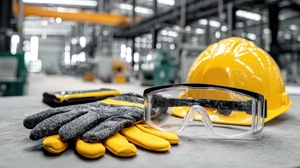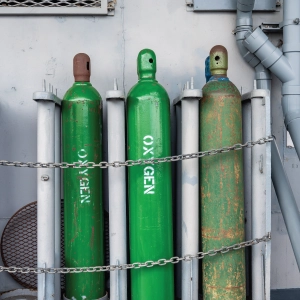Everything You Need to Know About a Commercial Driver's License

Introduction:
Do you want to start your career as a driver in the trucking industry? No matter the type of CDL you want, it is vital to understand the ins and outs of the Commercial Driver's License (CDL). This article will explain everything you want about the CDL license types, including their respective training, endorsements, and career prospects. So, get ready to learn all the nitty-gritty about the CDL license and project your career in the right direction with confidence.
A Quick Overview of Commerical Driver's License
A specialized driver's license that lets drivers drive commercial motor vehicles (CMVs) on public roads is called a Commercial Driver's License. You can drive vehicles such as buses, trucks, and tractor-trailers by having a CDL license, allowing you to transport passengers and cargo. This license system only lets qualified and skilled drivers operate vehicles safely and confidently. Acquiring a CDL license also lets you become compliant with the regulations set by the Federal Motor Carrier Safety Administration (FMCSA) and other state authorities.
What is CDL?
For large and heavy vehicles and cargo transportation, the United States has mandated using a Commercial Driver's License. You must pass the test and meet the requirements to get the license. CDLs are available in 3 different classes, as the Federal Motor Carrier Safety Administration (FMCSA) mentioned.Each class of CDL is designated for a particular vehicle type and purpose. The 3 types include:
-
Class A: The Class A CDL license is authorized for vehicles weighing 26,001 pounds or more. This category also includes towed vehicles of more than
10,000 pounds. Class A CDL license allows one to drive vehicles such as flatbeds, tractor-trailers and livestock carriers. - Class B: This license is authorized for vehicles of GCWR of 26001 pounds or even more, but for towing vehicles of 10,000 pounds or lesser weight. Class B CDL allows you to drive school buses, trailers, and dump trucks.
- Class C: Any other vehicle that is different from the description of Class A or B but carries more than 16 passengers or hazmat is referred to as Class C Vehicle. Class C CDL license allows driving these vehicles.
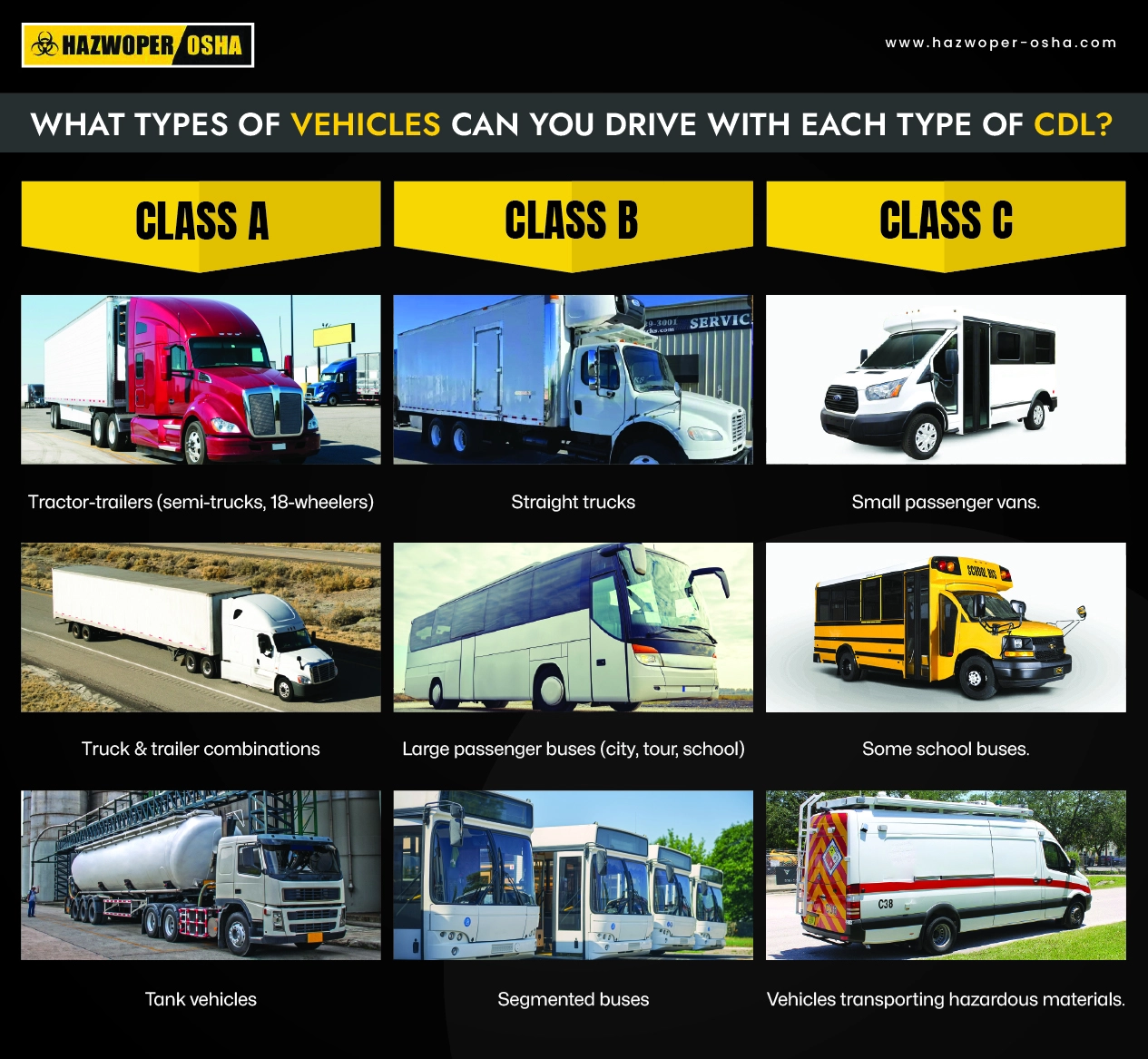
Below are some relevant CDL demographics and statistics about the CDL license:
- In the U.S., 1,198,085 CDL Class A drivers are employed.
- 93.2 % of Class A CDL drivers are men, and 6.8 % are females.
- The market demand for Class A CDL drivers is higher, with 95% of market turnover peaks.
- In the U.S., more than 661,446 Class B CDL drivers are employed.
- 90.1% of Class B CDL drivers are men and 9.9% are women.
- Class B CDL drivers are the highest-paid drivers in the construction industry.
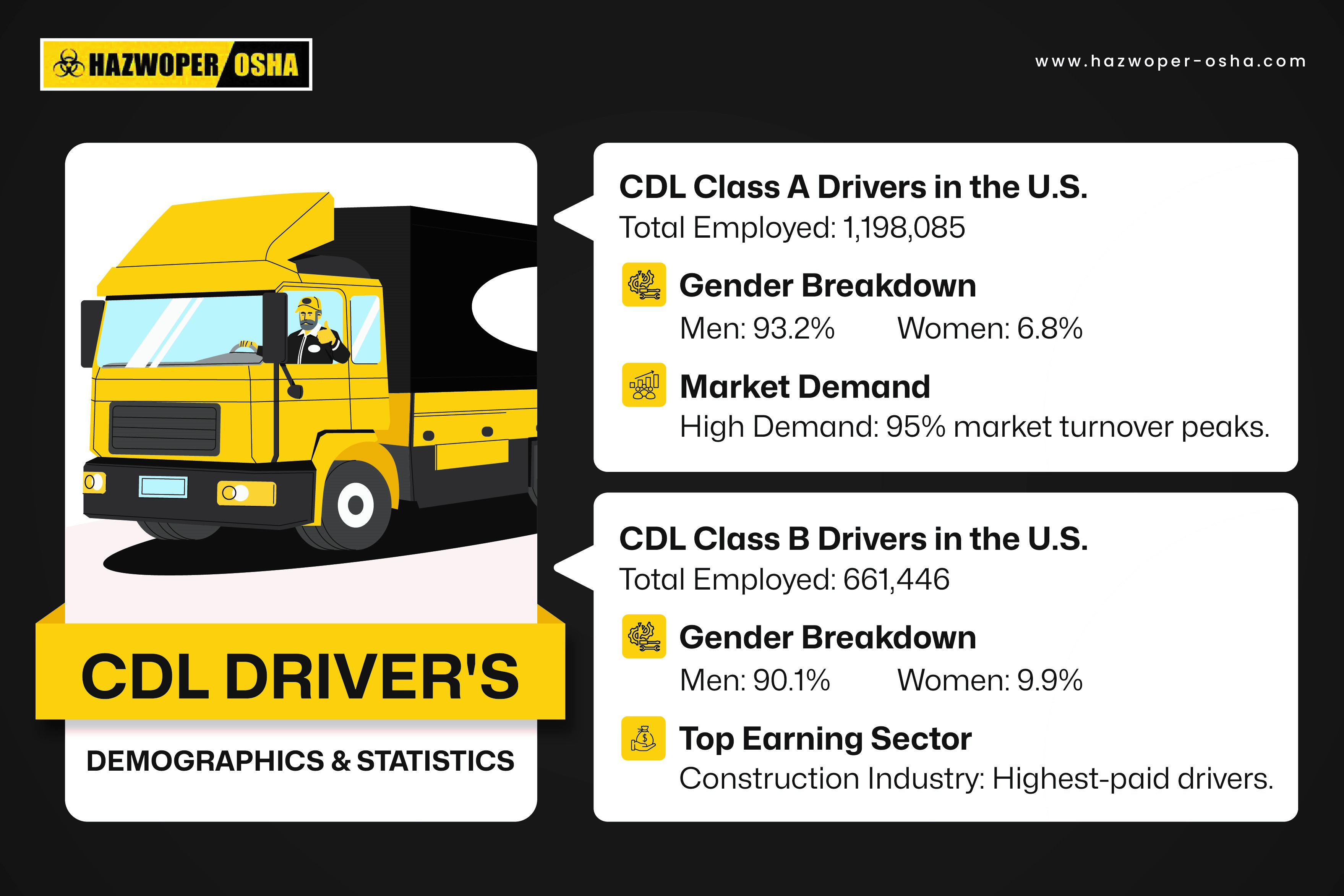
Caption: Demographics and Statistics of CDL Drivers.
These stats highlight the different demographics between these two CDL classes. If you want to learn more about Class A and Class B CDL, read our blog here.
Now that you have learned about the different classes of CDL licenses let's discuss the steps to get the CDL license:
Process to Get a CDL
In order to acquire the Commercial Driver's License, one must follow these steps:
- First, obtain the CDL manual for your respective state. Each state offers a manual that draws out the requirements and regulations for the license.
- Decide the type of CDL you want to obtain. Make this decision based on the type of vehicles you want to drive as a professional.
- Submit the application for a Commercial Learner's Permit and pass the required test.
- Get yourself enrolled in a driving school and complete the training under a licensed CDL holder.
- Hold the Commercial Learner Permit for the required period, schedule your skills test, and pass all the required components.
- After passing the tests, receive your CDL and can drive commercially.
DUI Impact on CDL Eligibility
A DUI conviction can have serious consequences for those holding or applying for a Commercial Driver’s License (CDL). Even if the offense occurs in a personal vehicle, a first-time DUI often results in a one-year CDL suspension. A second DUI may lead to permanent disqualification. CDL holders are also held to a stricter blood alcohol content (BAC) limit of 0.04%. Reinstatement may be possible under certain conditions, but it is subject to strict regulatory requirements.
What to Expect During CDL Training?
CDL training contains different facets, including classroom learning practical training and other skills. All these training types give you the essential skills and knowledge to drive on roads confidently and safely. Here is how this journey goes on:
Comprehensive Training Programs
Both classroom instructions and hands-on driving experience come undercomprehensive training. A comprehensive training program lasts many weeks, offering detailed coverage of safety regulations, vehicle operation, and pre-trip inspections. For example, the program can include up to 240 hours of training, including classroom lessons and practical driving practice. This in-depth training approach makes students well-prepared for the written and practical components of the CDL examination, encompassing defensive driving techniques, cargo handling and emergency maneuvers.
Hands-On Experience and Skills Tests
CDL training's crux is the hands-on training, as it lets the students practically apply what they have learned in a controlled environment. The hands-on training puts students in different conditions and lets them practice their driving skills in city streets, highways, and heavy traffic. Students become able to deal with all sorts of difficult situations. Additionally, students are trained to perform basic tasks such as coupling and uncoupling trailers, backing up, and conducting pre-trip inspections. Passing these types of assessments ensures that the license holders are well-versed and competent enough to operate commercial vehicles.
Choosing the Right Training Format
By choosing the right training format, one can get the maximum benefits of CDL training. Different formats are available for aspiring drivers, including part-time, full-time, and customized programs that serve personal schedules and needs.
Different schools offer flexible class timings, such as on weekends and evenings, making it smoother for students to get training along with other commitments. Also, there are programs who offer specialized training for particular endorsements such as double-triple trailers, hazardous materials that help the students to tailor their education to their career goals.
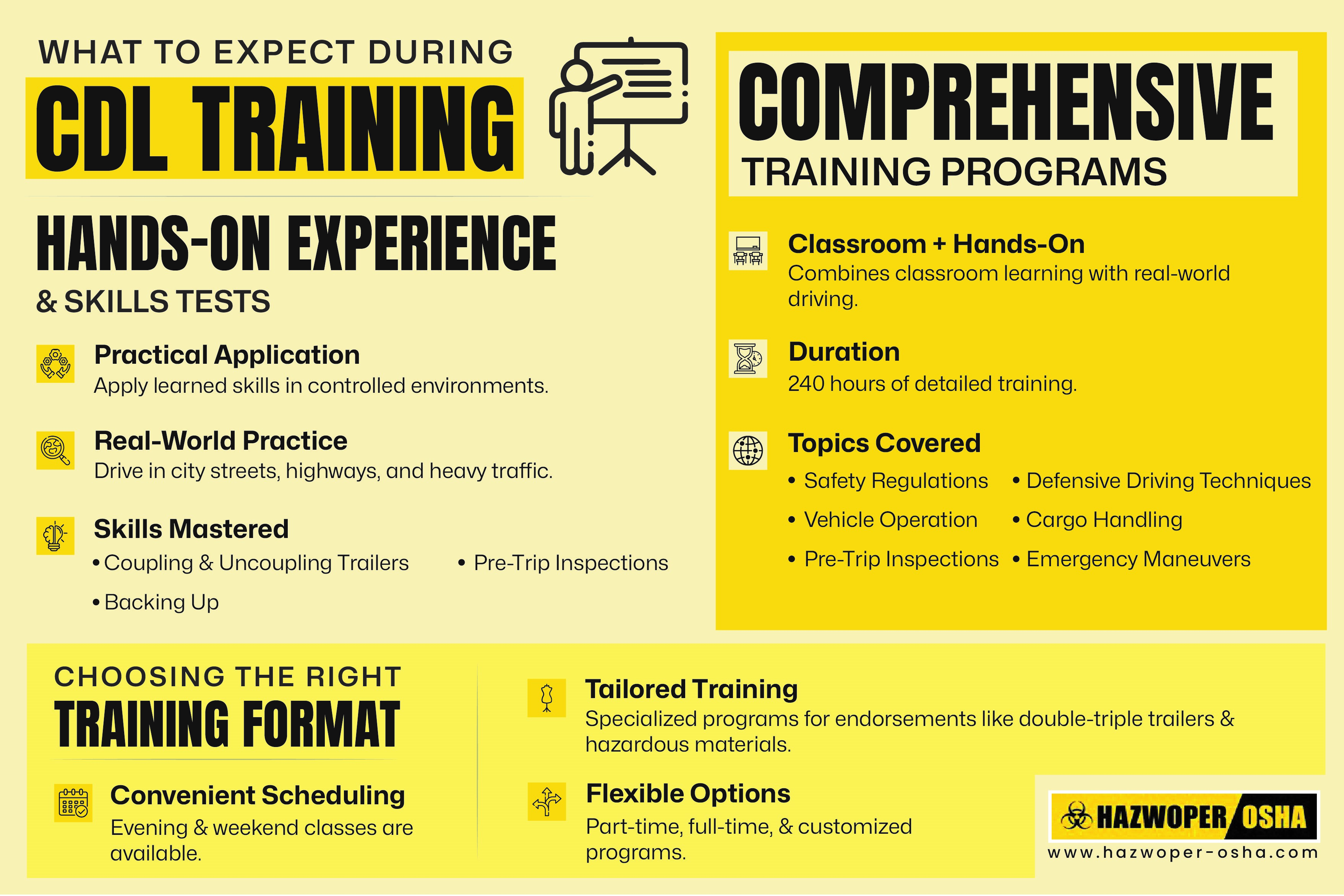
Caption: What comes under CDL Training?
Enhancing Your CDL with Endorsements
CDL holders can get various endorsements to allow them to drive several vehicles. The following is an overview of the different endorsements
-
The Passenger (P) Endorsement
With Passenger (P) Endorsement, drivers can drive school buses and vehicles that can transport 16 or more passengers. We, HAZWOPER Osha Training L.L.C., offer the CDL Entry Level Driver Training (ELDT) - Passenger (P) Endorsement course in online, onsite, virtual instructor-led, and SCORM formats. Enroll today and get certified anywhere in the U.S.A.
-
The Schools Bus (S) Endorsement
For school buses alone, the Schools Bus (S) endorsement is designed that needs additional testing.
-
The Hazardous Materials (H) Endorsement
With a valid Hazardous Materials (H) endorsement, you can transport hazardous materials, but the endorsement requires a federal TSA security threat assessment (fingerprint-based). If you’d like to review your public records beforehand, you can use a people-search service for a preliminary, non-official check (e.g., FreePeopleSearch). Note: such services are not official background checks and will not replace the TSA/state fingerprinting process required for the H endorsement.
-
We offer the CDL Entry Level Driver Training (ELDT) - HAZMAT (H) Endorsement course to help drivers meet these requirements. Our course is available onsite, online, SCORM, and in virtual instructor-led formats across the U.S.A. It is aligned with the FMCSA and D.O.T. Hazardous Materials Regulations 49 C.F.R. Part 171-180 regulations. Enroll today and secure your future.
-
The Tank Vehicle (N) Endorsement
Drivers who want to drive vehicles that transport liquids in bulk quantities need the Tank Vehicle (N) endorsement.
-
The T Endorsement
For drivers wishing to maneuver trailers need a T Endorsement for Double & Triple Trailers.
-
The Combination Hazardous Materials and Tank Vehicle (X)
The Combination Hazardous Materials and Tank Vehicle (X) endorsement allow drivers to transport hazardous materials in tank vehicles.
CDL training is not simply driving training, it includes mastering techniques and tools that help one to become a skilled professional driver. Understanding what is expected during the CDL training, you can confidently approach each lesson and ensure that you are on the path to a rewarding and successful career in the trucking industry.
Conclusion
A CDL license is more than a simple certificate; it is a key to unlocking the scope of exciting career paths. No matter if you want to have Class A CDL or Class B CDL, enjoy the steady pace of the local routes, understand the options
for your career, and make the right choice for your career. Choose the right training, endorsements, and career strategies and steer your career toward success. So why wait? Start learning today and begin your journey toward a dynamic and suitable career in trucking.
References:
Zippia, Class B Driver demographics and statistics in the US, https://www.zippia.com/class-b-driver-jobs/demographics/
Acvauctions, April 4, 2024, How to Get a Commercial Driver’s License (CDL), https://www.acvauctions.com/blog/how-to-get-a-cdl

 EN |
EN |  ES
ES













